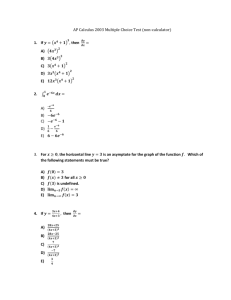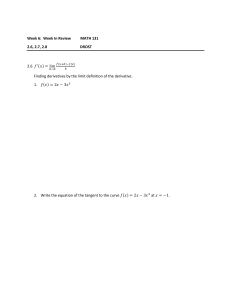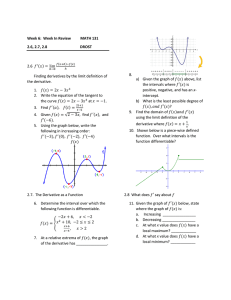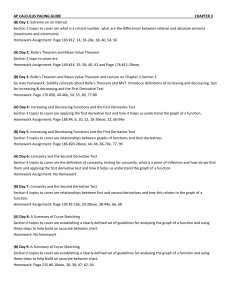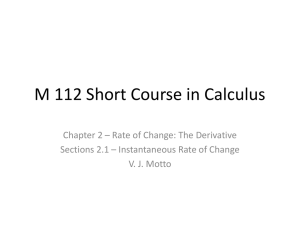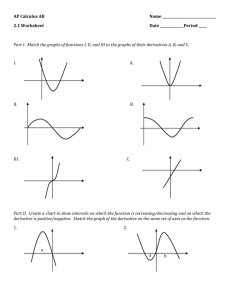Math1850 Outcomes
advertisement
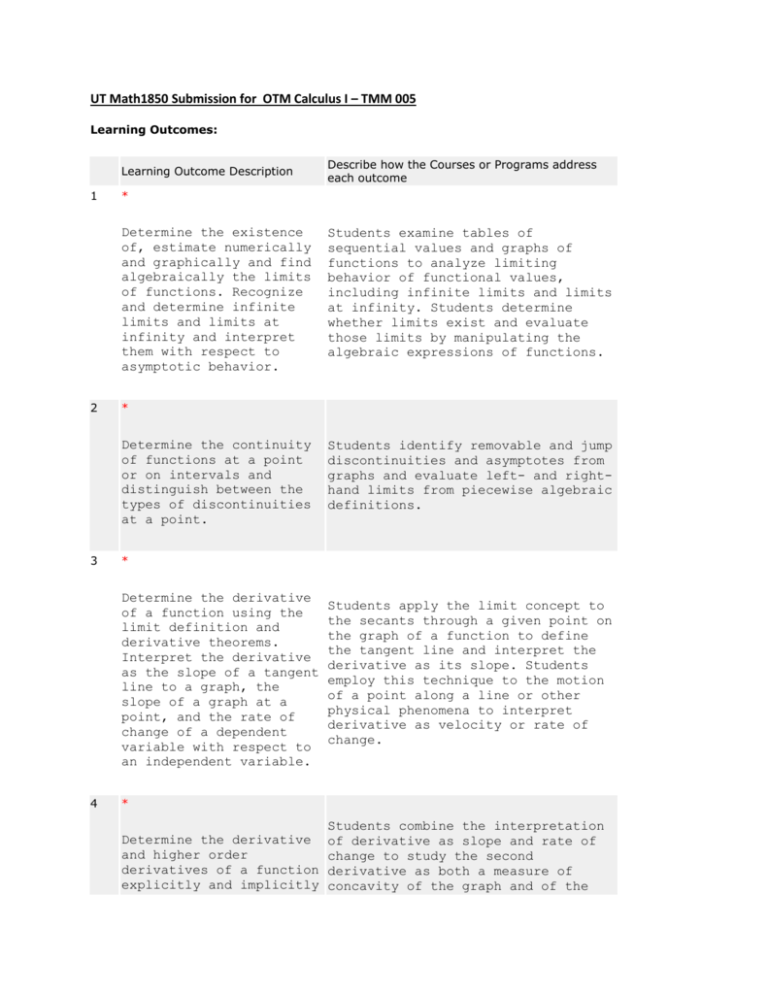
UT Math1850 Submission for OTM Calculus I – TMM 005 Learning Outcomes: Learning Outcome Description 1 * Determine the existence of, estimate numerically and graphically and find algebraically the limits of functions. Recognize and determine infinite limits and limits at infinity and interpret them with respect to asymptotic behavior. 2 Students identify removable and jump discontinuities and asymptotes from graphs and evaluate left- and righthand limits from piecewise algebraic definitions. * Determine the derivative of a function using the limit definition and derivative theorems. Interpret the derivative as the slope of a tangent line to a graph, the slope of a graph at a point, and the rate of change of a dependent variable with respect to an independent variable. 4 Students examine tables of sequential values and graphs of functions to analyze limiting behavior of functional values, including infinite limits and limits at infinity. Students determine whether limits exist and evaluate those limits by manipulating the algebraic expressions of functions. * Determine the continuity of functions at a point or on intervals and distinguish between the types of discontinuities at a point. 3 Describe how the Courses or Programs address each outcome Students apply the limit concept to the secants through a given point on the graph of a function to define the tangent line and interpret the derivative as its slope. Students employ this technique to the motion of a point along a line or other physical phenomena to interpret derivative as velocity or rate of change. * Determine the derivative and higher order derivatives of a function explicitly and implicitly Students combine the interpretation of derivative as slope and rate of change to study the second derivative as both a measure of concavity of the graph and of the and solve related rates problems. 5 acceleration of a physical quantity, such as a particle in motion. The student will apply Chain Rule and other rules of differentiation to implicitly defined quantities, including those involving geometric and physical relationships, to determine their relative rates of change and higher derivatives. * Determine absolute extrema on a closed interval for continuous functions and use the first and second derivatives to analyze and sketch the graph of a function, including determining intervals on which the graph is increasing, decreasing, constant, concave up or concave down and finding any relative extrema or inflection points. Appropriately use these techniques to solve optimization problems. Students will apply all of the concepts and techniques above to determine intervals of monotonicity, intervals of concavity, and interpret the transition points as local extrema or inflection points. Students will apply this method to sketch accurate graphs of functions, exhibiting all critical behavior; and to solve optimization problems, including those given in verbal form. 6 Determine when the Mean Value Theorem can be applied and use it in proofs of other theorems such as L’Hopital’s rule. Students will apply L’Hospital’s rule to evaluate limits of quantities expressed in “indeterminate form”. 7 Use differentials and Usually covered in class and linear approximations to midterms but not a course objective analyze applied problems. and hence not required for the final exam. 8 * Determine antiderivatives, indefinite and definite Students will analyze the areas of geometric figures using the method of exhaustion. Students will apply integrals, use definite integrals to find areas of planar regions, use the Fundamental Theorems of Calculus, and integrate by substitution. this concept to determine the areas of regions bounded by the graphs of functions, leading to the formal expression of the definite integral as the limit of Riemann sums. Students will study the inverse process of differentiation to develop the concept of antiderivative. In particular students will use the Chain Rule in conjunction with this process to develop the method of substitution. Students will link the concepts of Riemann integral and antiderivative through the Fundamental Theorem of Calculus, and apply it to determine the areas of planar regions analytically.

